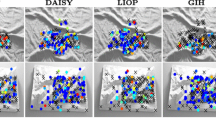Abstract
Human faces differ in shape and texture. This paper describes a representation of grey-level images of human faces based on an automated separation of two- dimensional shape and texture. The separation was done using the point correspondence between the different images, which was established through algorithms known from optical flow computation. A linear description of the separated texture and shape spaces allows a smooth modeling of human faces. Pictures of faces along the principal axes of a small data set of 50 faces are shown. We also show face reconstructions based on this small example set.
Access this chapter
Tax calculation will be finalised at checkout
Purchases are for personal use only
Preview
Unable to display preview. Download preview PDF.
Similar content being viewed by others
References
E.H. Adelson and J.R. Bergen. The extraction of spatiotemporal energy in human and machine vision. Proc. IEEE Workshop on Visual Motion, Carlston, pages 151–156, 1986.
J.L. Barron, D.J. Fleet, and S.S. Beauchemin. Performance of optical flow techniques. Int. Journal of Computer Vision, pages 43–77, 1994.
T. Beier and S. Neely. Feature-based image metamorphosis. In SIGGRAPH ’92 proceedings, pages 3542, Chicago, IL, 1992.
J.R. Bergen and R. Hingorani. Hierarchical motion-based frame rate conversion. Technical report, David Sarnoff Research Center Princeton NJ 08540, 1990.
D. Beymer, A. Shashua, and T. Poggio. Example-based image analysis and synthesis. A.I. Memo No. 1431, Artificial Intelligence Laboratory, Massachusetts Institute of Technology, 1993.
Ian Craw and Peter Cameron. Parameterizing images for recognition and reconstruction. In Proc. British Machine Vision Conference, 1991.
I.A. Essa and A. Pentland. A vision system for observing and extracting facial action parameters. Technical report 1301, MIT Media Laboratory Perceptual Computing Section, 1991.
P.W. Hallinan. A low-dimensional representation of human faces for arbitrary lightning conditions. In Proc. IEEE Conf. on Computer Vision and Pattern Recognition, Seattle WA, 1994.
A.J. O’Toole, H. Abdi, K.A. DefFenbacher, and D. Valentine. Low-dimensional representation of faces in in higher dimensions of the face space. J.Opt. Soc.Am. A, 10(3):405–411, 1993.
T. Poggio and T. Vetter. Recognition and structure from one 2D model view: observations on prototypes, object classes, and symmetries. A.I. Memo No. 1347, Artificial Intelligence Laboratory, Massachusetts Institute of Technology, 1992.
William H. Press. Numerical recipes in C: the art of scientific computing. Cambridge University Press, Cambridge, 1992.
L. Sirovich and M. Kirby. Low-dimensional procedure for the characterization of human faces. Journal of the Optical Society of America A, 4:519–554, 1987.
M. Turk and A. Pentland. Eigenfaces for recognition. Journal of Cognitive Neuroscience, 3:71–86, 1991.
Georg Wolberg. Image Warping. IEEE Computer Society Press, Los Alamitos CA, 1990.
Author information
Authors and Affiliations
Editor information
Editors and Affiliations
Rights and permissions
Copyright information
© 1995 Springer-Verlag Berlin Heidelberg
About this paper
Cite this paper
Vetter, T., Troje, N. (1995). Separation of texture and two-dimensional shape in images of human faces. In: Sagerer, G., Posch, S., Kummert, F. (eds) Mustererkennung 1995. Informatik aktuell. Springer, Berlin, Heidelberg. https://doi.org/10.1007/978-3-642-79980-8_14
Download citation
DOI: https://doi.org/10.1007/978-3-642-79980-8_14
Publisher Name: Springer, Berlin, Heidelberg
Print ISBN: 978-3-540-60293-4
Online ISBN: 978-3-642-79980-8
eBook Packages: Springer Book Archive




